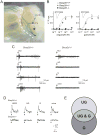Functional analysis of the guanylyl cyclase type D signaling system in the olfactory epithelium
- PMID: 19686132
- PMCID: PMC3863999
- DOI: 10.1111/j.1749-6632.2009.04104.x
Functional analysis of the guanylyl cyclase type D signaling system in the olfactory epithelium
Abstract
The mammalian olfactory system recognizes a wide range of chemical stimuli. The majority of cells in the main olfactory epithelium (MOE) use a cAMP-mediated signaling system to transduce odor signals. However, a subset of MOE neurons instead expresses components of a cGMP signaling cascade, including the receptor guanylyl cyclase GC-D and the cyclic nucleotide-gated channel subunit CNGA3. We used a combination of molecular biological, physiological, and imaging approaches to characterize this neuronal population. Neurons expressing GC-D show excitatory responses to the natriuretic peptide hormones uroguanylin and guanylin, as well as to stimuli present in urine, that are dependent on both GC-D and CNGA3. Though all GC-D-expressing neurons are highly sensitive to these stimuli, individual cells are differentially tuned to either one or both of the peptides. Together, these findings suggest that neurons expressing GC-D are part of a specialized olfactory subsystem that is responsive to semiochemicals.
Figures

Similar articles
-
Contribution of the receptor guanylyl cyclase GC-D to chemosensory function in the olfactory epithelium.Proc Natl Acad Sci U S A. 2007 Sep 4;104(36):14507-12. doi: 10.1073/pnas.0704965104. Epub 2007 Aug 27. Proc Natl Acad Sci U S A. 2007. PMID: 17724338 Free PMC article.
-
The receptor guanylyl cyclase type D (GC-D) ligand uroguanylin promotes the acquisition of food preferences in mice.Chem Senses. 2013 Jun;38(5):391-7. doi: 10.1093/chemse/bjt015. Epub 2013 Apr 4. Chem Senses. 2013. PMID: 23564012 Free PMC article.
-
Trpc2-expressing sensory neurons in the mouse main olfactory epithelium of type B express the soluble guanylate cyclase Gucy1b2.Mol Cell Neurosci. 2015 Mar;65:114-24. doi: 10.1016/j.mcn.2015.02.012. Epub 2015 Feb 19. Mol Cell Neurosci. 2015. PMID: 25701815 Free PMC article.
-
Evolution of the membrane/particulate guanylyl cyclase: From physicochemical sensors to hormone receptors.Gen Comp Endocrinol. 2022 Jan 1;315:113797. doi: 10.1016/j.ygcen.2021.113797. Epub 2021 May 3. Gen Comp Endocrinol. 2022. PMID: 33957096 Review.
-
Receptor guanylyl cyclases in mammalian olfactory function.Mol Cell Biochem. 2010 Jan;334(1-2):191-7. doi: 10.1007/s11010-009-0325-9. Epub 2009 Nov 26. Mol Cell Biochem. 2010. PMID: 19941039 Free PMC article. Review.
Cited by
-
Integrating temperature with odor processing in the olfactory bulb.J Neurosci. 2015 May 20;35(20):7892-902. doi: 10.1523/JNEUROSCI.0571-15.2015. J Neurosci. 2015. PMID: 25995474 Free PMC article.
-
Progenitor cell capacity of NeuroD1-expressing globose basal cells in the mouse olfactory epithelium.J Comp Neurol. 2011 Dec 1;519(17):3580-96. doi: 10.1002/cne.22726. J Comp Neurol. 2011. PMID: 21800309 Free PMC article.
-
One Special Glomerulus in the Olfactory Bulb of Xenopus laevis Tadpoles Integrates a Broad Range of Amino Acids and Mechanical Stimuli.J Neurosci. 2016 Oct 26;36(43):10978-10989. doi: 10.1523/JNEUROSCI.4631-15.2016. J Neurosci. 2016. PMID: 27798179 Free PMC article.
-
Receptor guanylyl cyclase C (GC-C): regulation and signal transduction.Mol Cell Biochem. 2010 Jan;334(1-2):67-80. doi: 10.1007/s11010-009-0324-x. Epub 2009 Dec 4. Mol Cell Biochem. 2010. PMID: 19960363
-
The Grueneberg ganglion: signal transduction and coding in an olfactory and thermosensory organ involved in the detection of alarm pheromones and predator-secreted kairomones.Cell Tissue Res. 2021 Jan;383(1):535-548. doi: 10.1007/s00441-020-03380-w. Epub 2021 Jan 6. Cell Tissue Res. 2021. PMID: 33404842 Review.
References
Publication types
MeSH terms
Substances
Grants and funding
LinkOut - more resources
Full Text Sources
Miscellaneous

